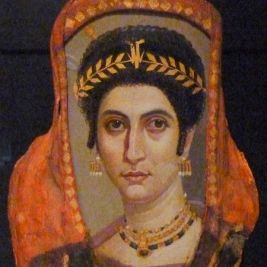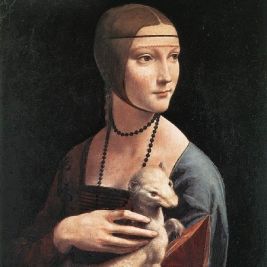
The painting "When Will You Marry?" by Paul Gauguin - bright colors of an exotic country
"When Will You Marry?" is a painting created by Paul Gauguin (Eugène Henri Paul Gauguin) in 1892. The composition features two Tahitian girls against a backdrop of blue shadow from a tree, gray mountains, and a yellow sky. Facing the viewer, they gaze in different directions, symbolizing the clash between Eastern and Western cultures. One of the figures is dynamic and positioned on the green grass of the foreground. Leaning on her hand, the girl leans forward, as if about to stand up and leave the scene. Dressed in flowing garments that harmonize with the surrounding colors, she embodies the spirit of freedom. A flower in her hair, according to local customs, signifies that the young beauty is seeking a partner and ready to embrace romantic passion. The image of the second girl, with her upright posture and prim manners, symbolizes traditional European values. Her conservative light pink dress with a white collar sharply contrasts with the vibrant colors of the Eastern landscape. Her fingers are folded in a gesture reminiscent of a Buddhist mudra, and her gaze is filled with condescension and disapproval. An attentive viewer notices that her figure is positioned at the optical center of the artwork, suggesting the dominant role of colonialism that engulfs the free customs of the islanders that fascinated the artist.
 Paul Gauguin. When Will You Marry?, 1892
Paul Gauguin. When Will You Marry?, 1892
- Title of the painting: "When Will You Marry?" (French: « Quand te maries-tu ? »; Tahitian: "Nafea faa ipoipo?").
- Artist: Paul Gauguin (1848-1903).
- Year of creation: 1892.
- Size: 105 x 75.5 cm.
- Style: Cloisonnism.
- Genre: Genre scene.
- Technique: Oil painting.
- Material: Canvas.
- Location: National Museum of Qatar, Doha.
Paul Gauguin is a renowned French painter and a prominent representative of 19th-century Post-Impressionism. His works were characterized by bold color experiments and a synthetic style. His art had a significant influence on the development of avant-garde art and artists of the following century, such as Pablo Picasso, Joan Miró, and Henri Matisse.
Paul Gauguin started painting at a mature age after working as a sailor and a stockbroker. He was inspired by vivid memories of his early childhood, filled with vibrant colors of Eastern life. Tired of dull and rainy weekdays, the 43-year-old artist embarked on a quest for exoticism in 1891, leaving his wife and five children behind. After several months in Tahiti, along with numerous other works, he presented the painting "When Will You Marry?" to the world.
Although the Polynesian reality did not meet Gauguin's expectations of a paradise island, the artist managed to capture his vision of the primitive life of the indigenous people in this artwork. Distorting perspective and dividing the composition into several planes with curvilinear lines, he filled the spaces with pure, intense colors, emphasized contrast, and abandoned detailed depiction of the characters. The missionary dress highlighted the influence of European civilization on Tahiti.
The painting "When Will You Marry?" by Paul Gauguin was only appreciated by contemporaries three years after the artist's death at a retrospective exhibition of his works. After being in a private collection of the Swiss family Staechelin for several decades, it was acquired by the museum authority of Qatar in 2015 and became the most expensive artwork in the world at that time. The transaction amounted to a record-breaking $300 million.
 Silver - a noble metal
Silver - a noble metal  The paintings "Bedroom in Arles" by Vincent van Gogh are iconic works of a brilliant master
The paintings "Bedroom in Arles" by Vincent van Gogh are iconic works of a brilliant master  Fresco is a breathtakingly beautiful form of monumental painting
Fresco is a breathtakingly beautiful form of monumental painting  Agnolo Bronzino was a great Italian portraitist and a brilliant intellectual of the Mannerist era
Agnolo Bronzino was a great Italian portraitist and a brilliant intellectual of the Mannerist era  Fayum mummy portraits - ritual painting that preceded its time
Fayum mummy portraits - ritual painting that preceded its time  Photography is an art accessible to everyone
Photography is an art accessible to everyone  The top 10 most famous photographers in the world - the best photo artists of all time
The top 10 most famous photographers in the world - the best photo artists of all time  Antique arms and armour from all over the world
Antique arms and armour from all over the world  The top 10 most famous Italian artists - the greatest masters of painting in Italy of all time
The top 10 most famous Italian artists - the greatest masters of painting in Italy of all time  Online auction at HERMANN HISTORICA 8-13 July 2024: Kunst, Antiquitäten & Antiken
Online auction at HERMANN HISTORICA 8-13 July 2024: Kunst, Antiquitäten & Antiken